#white rabbit cabaret
Text
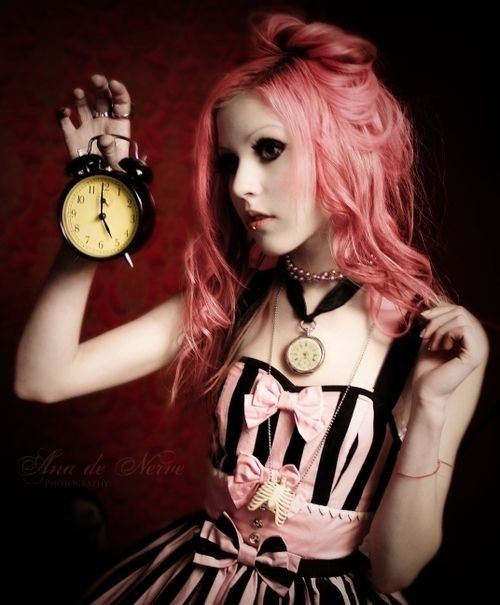
#creepy#alice in wonderland#gothic alice#doelet#white rabbit#wonderland#dark cabaret#pastel goth#pink#carnival#circus#alice madness returns#mad hatter
55 notes
·
View notes
Text
i love dark cabaret!! i love bands that embody alice in wonderland and sound like they were made for tea parties with white rabbits!! i love emilie autumn!! i love rasputina!! i love the birthday massacre!! i love kerli!!
56 notes
·
View notes
Text

I love alice in wonderland and alice: madness returns themes so much. the victorian era, red, black & white, rabbits, clocks, stripes, dark cabaret vibes, teeth, the creepy & macabre, dolls, knives, tea cups, bugs, strange creatures, surgical instruments, the portrayal of what its really like to experience hallucinations, psychosis, delusions, or just mental illness in general.
not only do i adore all of these aesthetics, but as someone who has personally experienced auditory and visual hallucinations/psychosis, depersonalization, and delusions myself, it really makes me happy seeing ppl turn something that i've struggled with into something beautiful, artistic and poetic.
i've escaped to my head more times than i can count in an attempt to escape trauma. sometimes purposely and other times involuntarily when experiencing traumatic situations. i've struggled to know what is real and what isn't. i've had to grow up with a mother who still to this day tries to convince me that certain events didn't happen when i know for fact they did because my sister went through them too. my mind has never been quite right or "normal." i've lost my mind many times. i've struggled to make friends my whole life because i don't think or act like most ppl despite desperately wanting to fit in. and then throw autism on top of all that, and you have a scared, lonely, shy & anxious wreck of a girl.
you see, i love to play around with aesthetics, and share my interests, but the stuff i post online goes so much deeper than just looking visually pleasing to people. these things i care about so much are my very heart and soul. my interests are basically who i am. people may find it strange that i care so deeply about bugs and rabbits, but to me it resonates with me so deeply that i can't even put it into words.
i've always loved alice in wonderland, but when i discovered alice: madness returns i REALLY knew then that i found exactly what i've been feeling my entire life. that game, those characters, that realm describes my mind and my personality and my trauma so well that its actually crazy to know someone out there had those same ideas living in their head.
oh what i wouldn't give to have a conversation with american mcgee🥺😭
maybe i'm just ranting again but i just wanted to share a bit about myself and why i love the things i post about. it really means the world to me when i find likeminded people on here. its so precious to me when i talk to people who have a connection to the same things i do.
so yeah i'm not kidding when i say my tumblr is just the inside of my brain😹

33 notes
·
View notes
Text
A Beet by Beet Analysis - Part 4
This is part 4 of this explanation/analysis. To see the other parts, click here.
Another hard cut brings us backstage at a theatre. It’s raining white rabbits, and a giant prop rabbit draped in lights lies in the foreground. Keep an eye out for this one too, it will return. What does white rabbits make you think of? Harry; a magic show is surely afoot.
In the bottom left sits an open box or case illuminated from within, and we see what has to be a gun attached to the inside of its lid. High in the background we also see an illuminated beetroot, or radish, or some such thing (hey, just like the title of this text!). No idea how or why or if this might be significant. The walls seem to be timber frame. There’s a grand piano and three makeup mirrors in the background.
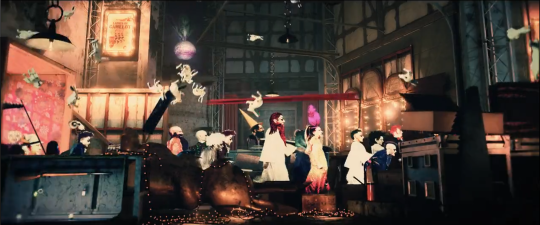
Passing on through a wall we step onto the stage! Behind a humongous magician’s top hat we see four cabaret dancers high-kicking their way through the procession. On the walls above them two posters are visible, declaring the Ladies of Camelot to be at the Windmill Theatre, with three ladies in similar poses.
There is writing on the backs of the chairs but the video’s resolution obscures the letters. Another of the prop bunnies is in the seats, along with a man in a hat. We’ve caught up with the front of the procession, and Crowley comes to a halt on stage across from the robed and winged magician: Aziraphale. Behind him is a large, spinning knife-throwing target with the outline of a body across its middle. Our magician creates a cloud of smoke and the stage curtains part to reveal: space!
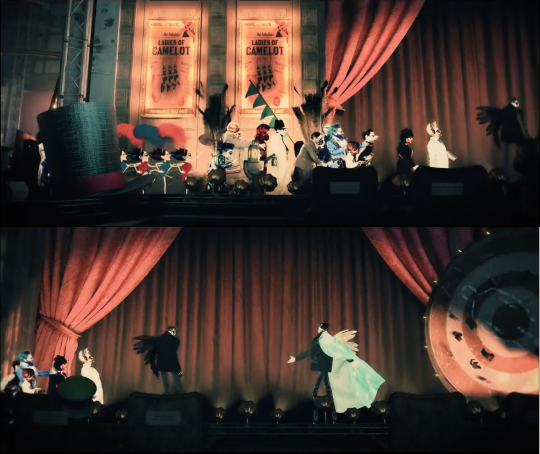
To see the other parts, click here.
#good omens#gos2#good omens season 2#good omens s2#good omens 2#good omens meta#title sequence#maddie's beet by beet analysis
30 notes
·
View notes
Text
Summer_Knowledge RYM 2023 Wrapped
Hey everybody welcome to my 2023 rateyourmusic wrapped.
I listened to 137 albums this year. This is 13 less than last year but around 5 more than my average since 2019.
Decade stats:
1960s: 6
1970s: 9
1980s: 27
1990s: 63
2000s: 25
2010s: 5
2020s: 2
None of this really surprises me that much but I did think that the 2000s would have beat the 80s. 70s really fell off from last year.
Genre stats:
These stats are based off of rym primary genres. I listened to 65 genres total. That is almost 10 more than last year.
1. Indie rock (30)
2. Alternative rock (26)
3. Power pop (25)
4. Shoegaze (10)
5. Pop rock (9) and indie pop (9)
Not surprising whatsoever.
Most notable first-listens:
Okay I thought it would be fun to choose my favorite albums and favorite songs that I heard for the first time this year. But it’s not really favorites it’s just what I found to be the most notable and impactful I guess because if I was listing my favorites I would just look at my last.fm account. Also I limited to 1 per artist.
Albums:
1. Whale Music - Rheostatics
2. Whatever and Ever Amen - Ben Folds Five
3. The Walking - Jane Siberry
4. Sweet Homewrecker - Thrush Hermit
5. Operation Infinite Joy - Martin Tielli
I only picked five because while trying to pick albums I realized that the vast majority are not very impactful. Also four of these are Canadian.
Songs:
1. Palomar - Rheostatics
2. Behind This Wall - Turning Point
3. Stood Up - Matthew Grimson
4. The White Tent the Raft - Jane Siberry
5. Emaline - Ben Folds Five
6. Sally Ann’s (Style Denial) - Local Rabbits
7. Winnipeg - Martin Tielli
8. Darkness - The Police
9. North Dakota - Thrush Hermit
10. Being With You - that dog.
Nothing really of note here except there’s a lot of Rheostatics songs I could have chosen. Also 6/10 of these are Canadian.
Other notable things:
The Rheostatics obsession was reallyyy bad I scrobbled them almost 5,000 times since first listening in May. I can’t overemphasize that. Also I want to just mention the thing I had for heartland rock in May and also my brief obsession with 90s country pop hits that happened earlier this month. Also I was really obsessed with Leave this City by the Sundays but because I didn’t listen to it for the first time this year I couldn’t include it in my top 10 but if I could include it in my top 10 it would be like number 3. Also I reached 1k Blake Babies scrobbles.
My predictions:
So last year I predicted that I would listen to more shoegaze and I did!!! I also predicted that I would listen to more new wave and I listened to (1) new wave album this year so that did not happen. The surf phase that I tried manifesting also didn’t happen. Instead I had a weird Rheostatics phase, a subphase of the main canrock phase that has been dominating my life for a year and a half. I predicted I would listen to less albums overall which is true!!!!!! And that I would listen to more 80s albums which also happened.
My future predictions are that the Rheostatics phase will be strong for around another 6 months and then finally die out. After that I literally can’t imagine how the canrock phase will continue so I’m predicting that twait no I think that Sloan will tour Smeared in 2024 reviving my canrock phase and shifting its focus to noisier material. I also predict that I will develop a weird phase for something like cabaret or if it’s less weird than that like. Chamber pop. I predict that I will listen to slightly less albums overall. I predict that the 90s will continue to be my most popular decade.
Thank you everyone I would like to thank sonemic and last.fm and discord for these extraordinary stats. Happy new year
5 notes
·
View notes
Text
A poem by Rachel Wetzsteon

Cabaret Ludwig
I’ll fly off to a fjord in Norway,
post “Oh the pain” above my doorway
if you insist on going your way,
for this is not a duck.
That is what cowards say, and realists
who run away, shun the appeal its
rare white fur holds, although they feel it’s
a rabbit full of pluck.
Let’s multiply, let’s twitch our noses,
let’s walk among the night’s dark roses,
though where the oldest story goes is
a place where tongues might cluck.
I’ve had my share of quacks and hisses;
whereof mouth cannot speak, it kisses;
hop to it, man, and realize this is
a lovely bit of luck.

Rachel Wetzsteon
(1967-2009)
2 notes
·
View notes
Note
hello zero. do you have a rec list of songs? a playlist?
ok, so theres no easy answer for this
idk how to describe my musical tastes. i guess i could put them in a 3-axis graph, like this, and just kinda let the artists fall where they may
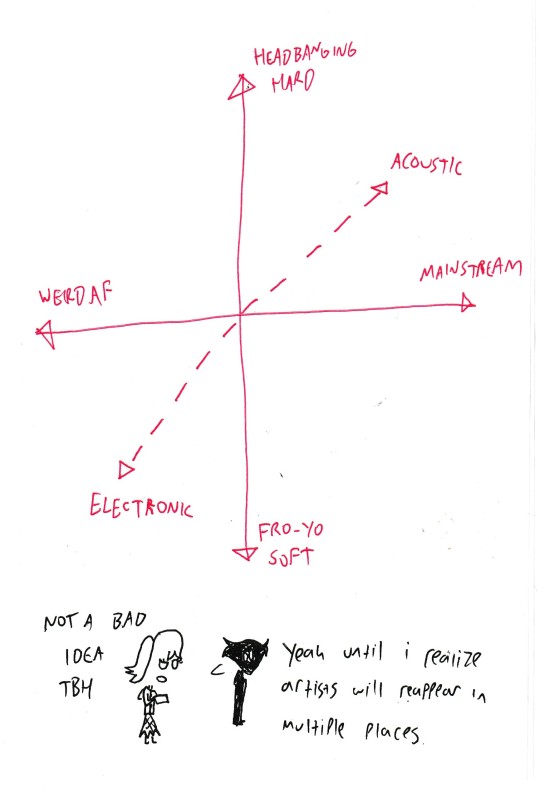
ive always enjoyed obscure and acoustic indie artists, as well as weird and obscure rock bands and mainstream rock bands. im always scared to "actively" listen to music for some reason. ill just find something i like and then seek it out organically after listening it.
pink floyd - i used to listen to my mom's pink floyd CDs on my sisters stereo a lot. my mom bought them to entertain guests whenever her friends would come over for drinks. 'Animals' is my favorite, and i never got into 'Dark Side of the Moon' that much but i liked its themes. 'Animals' gives me feelings of being a kid and imagining what it's like to be an adult. if you look at the album art for 'Wish You Were Here' along with the art and lyrics in the CD booklet, it all gives a very futuristic machination feel and it unnerved me so much i didnt listen to it. it scared me. now i love it, and its my favorite PF album art. look up tattoos of it, its great.
the real tuesday weld - contender for my fav band. i own physical music from them more than any other artist. i saw the video for Bathtime In Clerkenwell as a kid on MTV and it blew me away (anyone who knows me knows i love animation + black and white + russian art). when i realized it wasnt just a video but a music video for a band, i went down this rabbit hole of the entire band and it made me appreciate weird electronic lounge music. this is what P!ATD tried to do but failed spectacularly. its music from the past if they had the tools of the future. i listen to their music and i feel like im dreaming, its ethereal. their last album they released (the next to last to be released) was called Dreams and thats what i feel when i hear them.
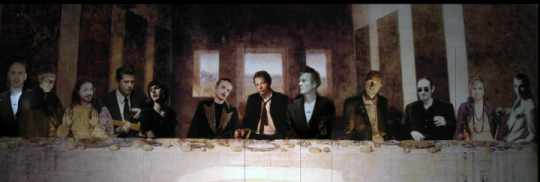
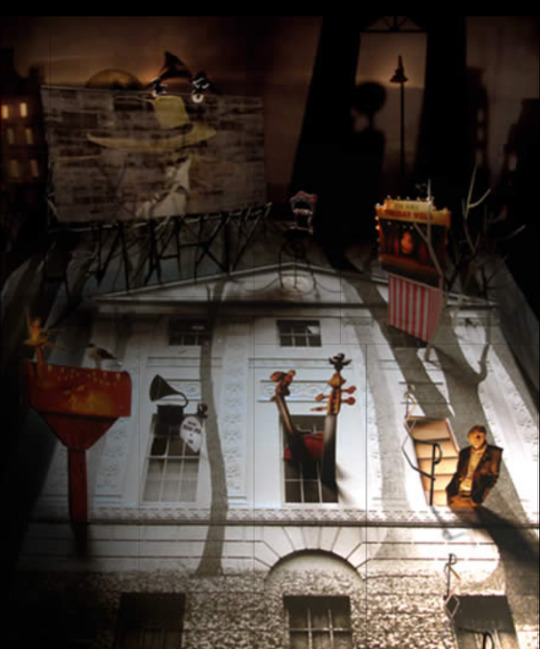

i think my fav songs lately are Let It Come Down (calming jazz lounge) Silicone (noir theme for two fucked up lovers) One More Chance (cabaret duet letter from Lucifer addressed to God). one of my fav videos is probably the one for Me And Mr Wolf (contains blood and cartoon violence) my popsocket is lifted right from the video. it looks rough, i know

the peculiar pretzelmen - i heard these dudes bc i was actually looking for music like TRTW. they describe themselves as "voodoo death stomp" and it reminds me i love sad angry folk music and bluegrass. you, yes you, specifically, notfredjohnson, ive told about them to before. i have listened to a LOT of their work all year and are my current go to for music to listen to during my drive to work.
rabbit foot blues - hardcore romp ode to those with nothing and everything
sing along - how do you accept that someone doesnt want to be in your life anymore? i guess sing a song
crazy man michael is an amazing heartfelt cover of a beautiful song from the 70s
other songs i tend to like a lot solely bc i REALLY like female vocalists. i just do, they carry so much pain and hurt in their voices that just comes natural to a female singing voice.
behind these hazel eyes by kelly clarkson, nobody's home by avril lavigne, im sorry i love you by the magnetic fields, sober by p!nk, the lions roar by first aid kit,
diamonds cutting diamonds by lydia ainsworth, waiting around to die by the be good tanyas, iron horse by mean mary, with me wherever i go by laurie lewis
theres so much more in so many weird and different genres so i think ill close with ein astronaut. heres turn, which im obsessed with (i fucking love accordion) and here he is doing vocals for WREN in she'd never know
3 notes
·
View notes
Text
Brent Aldrich
Indianapolis, IN


100 Larrys
2021-2022
drawing and water-based media on paper, dimensions vary
Small, $50 each | Large, $75 each
View complete 100 Larrys series here.
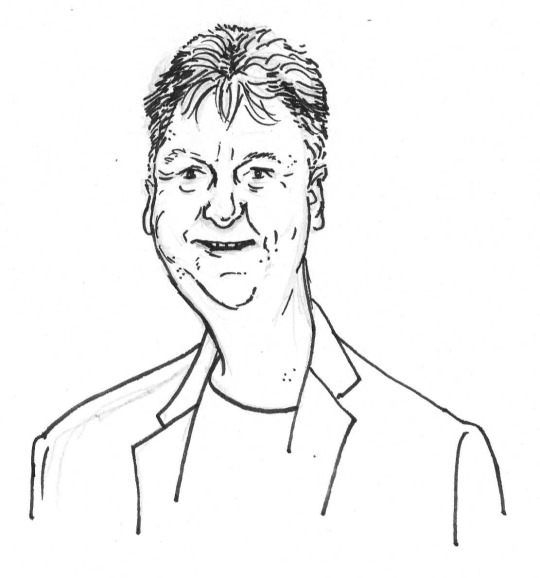

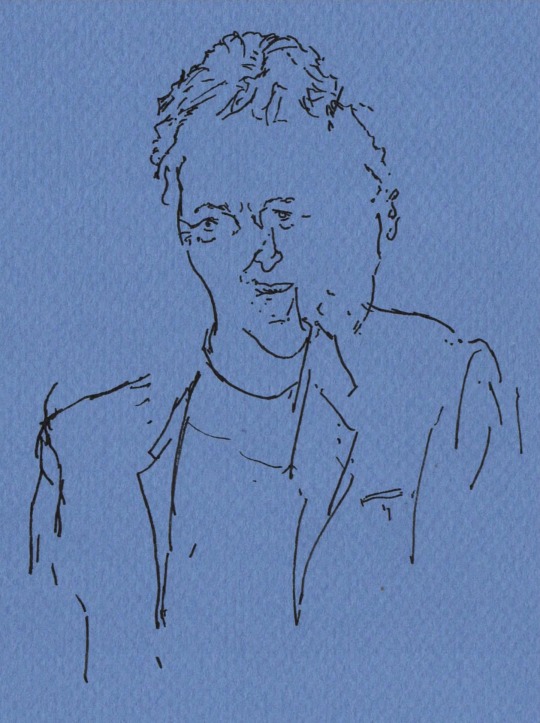

Brent Aldrich is an artist from Indianapolis, whose art practice informs all other roles spanning arts education, curation, administration, art handling and installation. Aldrich has an MFA from Herron School of Art & Design, and his first professional arts job was as a drawing instructor for Herron’s illustrious Saturday School program in 2007. In the 15+ years since, he has developed a practice that is relational and experiential, locating artistic practice and creative labor as sites of transformation.
Recent projects include the exhibition Lunch People as a visiting artist at the University of Northern Colorado with Jon Love; host of a monthly reading series produced by Jennifer Delgadillo with creative writing MFA students from Butler University; and producer and performer of live shows at the White Rabbit Cabaret, alongside a collection of overhead projectors, cardboard props, and performers with DB Improv Collective.
brentaldrich.com
@btaldrich
0 notes
Text
Triva Brawl at the White Rabbit Cabaret - March 27, 2018
Since 2007, Trivia Brawl has rampaged through bars across Indiana, shattering conventions and brains alike in its quest to put on the best (or at least strangest) pub trivia gameshow you've ever seen, featuring multimedia tomfoolery, audience participation, and live performers. Now you can see it live at The White Rabbit Cabaret!
This month's special guest performer:
Eric Salazar, clarinet warrior
Special topics to be announced soon!
Find the signup post in the discussion session and comment with your team name for an early-signup bonus point!
Doors open at 7pm, show starts promptly at 8pm
Admission: $5 (21+ w/ ID)
Hosted by brain-arsonists Phantom Watson and Jason Hoffman
Prizes sponsored by your mouth's best friend, Kuma's Corner Indianapolis
Questions? Send a message to https://www.facebook.com/TriviaBrawl/
1 note
·
View note
Text
Neon Gods | Platonic Scenario
Yandere!Emperor Nefarious & Doctor Nefarious
WARNING: morally ambiguous reader, alcohol use, non-consensual drug use (not by either Nefarious), violence, implied death, psychological manipulation, toxic mindsets.
WORD COUNT: 4.195
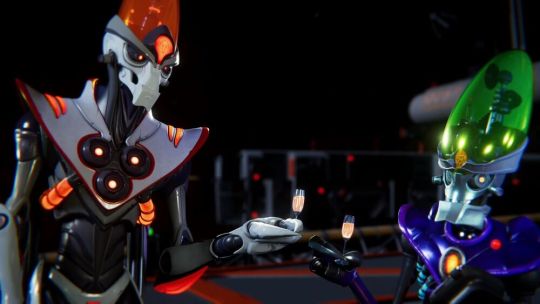
AT A TIME when most organic beings surrendered to their weariness, robotic citizens powered by batteries and self-sustaining engines wandered the streets like wayward souls awaiting Charon's ferry.
Even the downtrodden and most obscure areas of the city, the type of places one would travel to find a fight or vanish, were dripping with neon signs and enormous television screens that sang the praises of their emperor.
His angular face stared back at every passerby, and the absence of darkness inflicted a sense of surveillance no matter how far from the tower you walked.
Rivet descended from the rooftop of a mechanic shop like a superhero from the comic books of old. The black surface of her helmet displayed a blue smiley face, which ceased as she removed it to expose white fur and large, pointed ears that were not unlike those of a fennec fox.
"I had to blow off Le Fer to make it, so you better not double-cross me," she teased with a lighthearted chuckle that implied the situation was more of a fun trick to her than the potentially fatal risk it was to you.
The rebel dropped a handful of silver balls that were the perfect size for a game of ping pong onto your palm, her fingers lingering on yours as if ensuring that you kept them. A symbol of the revolution—a 'V' that mimicked the shape of Lombax heads—was imprinted on the side of each one. You were not certain whether it was a deliberate insult or a grievous oversight, yet Rivet patted your hand as if thinking it a gift.
Seekerpedes, the aerial guard dogs of Nefarious City that had all the grace of a whale swimming in the ocean until you noticed the extra legs and mandibles that threatened to bite like a saltwater crocodile, glided overhead as a reminder of your entrapment.
A melody that paramours danced to in the secluded night echoed in the alleyway, a mere whisper to your ears but a flourishing attraction for the cabaret down the street.
"Electric shock grenades." Rivet offered a wink, seemingly unaware of the malevolent thoughts that poured into your mind without restraint. "In case you need to deactivate a few bots." This explanation merely encouraged your hateful fantasies to grow, but allowing yourself to believe that a collection of pocket tools could dethrone him was a celebration of naivete that reality would jump to disprove.
You had begun to pull your hand away when Rivet tightened her grip. The Lombax flashed a smile that she expressed with great hesitancy—both for fear of a poor reaction and given the hordes of Troopers patrolling the city—that was equal only to her determination for you to see it, but her next words were an even bolder declaration. "You'll always have a seat on my ship."
* * *
WHEN YOU SNUCK into the throne room to behold a slouching robot with an oblong head prancing to the desk, there was a brief thought that the emperor had undergone some sort of physical tragedy in his conquest and decided to postpone it.
The voice that revelled in the splendid acoustics, however, was raspy and sitting on the cusp of giddy. A quick examination of the gold statue upon which you idled behind furthered your skepticism about announcing yourself, but the intruder spotted you with an ecstatic gasp.
He looked with the euphoric relief of someone who had reached the end of a maze after hours of stumbling, overwhelmed by familiarity and a sense that the trials that delivered him to the other side had all been worthwhile. The texture of his metal was much darker and more compact than that of the emperor, and the dim light provided by the giant monitors behind him cast a thick shadow across his body.
Bewilderment and fright seized your being when he hopped the desk like a rabbit and began sprinting in your direction. The clanks of his metal feet echoed in the expansive chamber, and the handful of sentries that blocked his path scattered with as much fearful urgency as their rudimentary programming could muster.
You thought he was going to tackle you, but the robot paused at the opposite end of the statue. His steps forward, despite the look of pure joy on his face, were slow and meticulous. He raised his arms to his chest like a child eager to see what their parents had gifted them for their birthday.
Doctor Nefarious extended a hand towards you as if wishing to confirm that you were not a hologram or some intangible figment of his psyche, and his serrate fingers that resembled the elongated claws of a honey badger stretched nearer. Despite the meagre space between the two of you, he continued to draw closer until you recoiled slightly.
"Who are you?"
A flash of surprise caused his hand to lower a bit, then a sliver of disappointment weakened his smile before he seemed to find a silver lining.
Bursts of laughter -- a premature celebration of dubious victory -- rattled his neck joints as he grasped the leg of the statue with one arm and began spinning around it. Lifting his leg into the air, he angled his head at the ceiling and embraced a bout of hysterical cackling.
You turned to the security bots in expectant confusion about why he was allowed in the tower, but they stood at attention as if facing the emperor himself.
Seeing you was like watching a corpse sprout from the earth when its burial had been attended by many. "I knew someone like you once," was the extent of his answer, one given with an audible degree of hesitancy and a twinge of sorrow as if he were digging up a fresh grave on a rainy day.
* * *
THE FIRST TIME you saw him should have been the last. A bot sworn to the limits of its coding would have ejected him from the headquarters at the tiniest discrepancy, yet it was your liking of his more timid approach to controlling you that persuaded the guards to await a direct command from the emperor. When the skeletal robot returned with this lookalike intruder by his side, their combined persistence eradicated most opportunities to slip into the city for a night to yourself.
Unlike the insistence on your joining his subjugation of the cosmos and watching him annihilate rebels, the doctor was focused on simply keeping you inside the base. "What?! You want to bump elbows with squishies?" cried Doctor Nefarious. The prospect seemed to slap him across the face, but his taller counterpart found amusement instead of surprise.
"Don't be too shocked. Our—" the phrase arrived after a disgruntled pause as if the emperor were hoping for new information that would have saved him from speaking it "—mutual friend used to be quite the ally of squishies." Emperor Nefarious emerged from the shadows cloaking the base of a statue with gradual, deliberate strides, the glow of his orange eyes betraying his presence before the warm colours of the monitor peeled the darkness off his white metal.
With each door guarded by an ever-vigilant pair of droids who feared a journey to the depths of universes where eternal torment was given like fruit baskets to new neighbours, charisma was not a viable method of escape. "Your firewater, Emperor," chirped the white and pink Assistant, who flew to his desk with a trio of goblets. The glasses clinked as they were lowered and appeared dwarfish next to the clear bottle in his hand worth more than most citizens would earn in their extended lifetimes.
A pop reverberated through the chamber as the cork bounced into the waiting hands of the Assistant, and the bubbly texture of fizz proceeded to spill from the top of the bottle like a volcanic eruption. "I thought we might celebrate my return." The emperor fell onto his leather throne with his legs crossed and one arm elevated behind his head and held his share of the champagne as if he were in a portrait and the drink was merely a prop.
Doctor Nefarious dragged his chair to the front of the desk in anticipation of what he thought to be a bonding experience, lightly bouncing in his seat and fingers tapping the edge of the table.
The champagne was the colour of bubblegum and lemonade, tasting a delicate hybrid of citrus and cherry. A floral aroma wafted into your nose as grapes plucked from the most vibrant and fruitful gardens in the universe. It was a beverage that many an impoverished citizen would consider a glimpse into Shangri-La or Elysium, yet nothing but a mild sip was all you managed.
Eyes flickering between the goblet and you, Emperor Nefarious observed your reluctance to indulge with vexed impatience. "Pondering an upgrade?" The mordant edge that had infected his voice like a spark of fire sharpened as he raised his glass to his face. "It's not like you drink much, anyway." A light swirl of the champagne drew a look of indifference from the skeletal robot, and his gaze floated in your direction.
"Or eat, for that matter."
Silence pervaded the throne room as if it were a pestilence sprinkling its wickedness from one village to another. Doctor Nefarious leaned forward to press his goblet to the tip of his metal mouth, watching the interaction like someone uncertain about their role in it while he attempted to imitate your action. The liquid splashed against his jaw and plopped on the floor in strings of droplets, and the doctor scanned the nearby security bots with defensive suspicion. Every droid in the vicinity, except the Assistant who continued to hover beside the emperor, turned away.
When Doctor Nefarious returned his attention to you, his expression became one of a kid opening a present. "Oh! I have all sorts of parts in my dimension!" The interjection earned a look of distaste from the skeletal robot. He considered it a trite and desperate attempt to win the conversation, and his trek to a few paces beside the desk was marked by a sardonic refusal to face either of you.
"Perhaps I have been a bit—" he tossed the next word with audible humour "—overzealous as of late." When Emperor Nefarious turned to display his wry scheme, a part of you said goodbye to the tower. "It's best not to forget the little things, after all." The emperor sauntered to the back of your chairs and leaned over, resting his arms on your and the doctor's shoulders. "What say we have a night out?"
* * *
IRRITATION AT YOUR INTEREST in a drink outside his private collection prompted Emperor Nefarious to shake his head and turn away. The shelves of alcohol, some local brands and others imported from galaxies that would take a human's entire life to reach, comprising the rear of the bar were a child's birthday party compared to his extravagant array of liquor. It was a disgrace for any of it to enter your system, and watching his counterpart cling to you like a lost puppy aggravated his brooding into action.
"Don't drink that swill in front of me!" With a swipe of his hand, the section of the floor adjacent to you was drenched in a thin layer of bronze liquid. The glass had miraculously not shattered into jagged bits that embedded themselves in your skin and instead rolled across the table like a sideways coin. A soft fabric began to pat different areas of your face, and you realized that Doctor Nefarious had stolen a handkerchief from the neighbouring table and was cleansing you of various liquor droplets.
A Trooper, the ovoid enforcers whose shape emulated the emperor's head, glided to the booth. In an automated voice that was as deep as many envisioned a demon to sound, it asserted, "Emperor, the rebel Lombax has been spotted near this establishment."
The doctor pulled back—a fact you were grateful for because a hint of a smile crept onto your face—and comprehended the news as if his veil of reality had failed for just a moment and appalled him with what it revealed. Annoyance had been his initial response to the interruption, but the potential to be caught without his full arsenal prompted Emperor Nefarious to stand up and follow the droid into the throng.
As the thought of disappearing out a back door drifted into your boredom, you slowly turned to peek at the smaller robot.
Doctor Nefarious was fiddling with a chip of loose paint but was excited to receive an inkling of your attention, finding his courage in the absence of his counterpart. "What would you say to visiting—" the uncertainty with which he pronounced the word indicated an ulterior motive "—another dimension?"
Within a minute of the emperor's departure, a rawboned alien hobbled to the table. "The bartender wants to offer replacement drink. Much higher quality," they stammered in a broken and awkward fashion. You managed to swallow a third of the glass before it was snatched by an infuriated robot. Tolerance depleted and knowing the doctor would not impede like the emperor would, you exited the booth and headed to the restroom.
The table rattled as Doctor Nefarious slammed his palms onto it and rose from his seat like darkness ascending, meeting the alien with the glare of an animal preparing to strike.
White powder swirled in the core of the liquid, touching the bottom of the glass before assimilating the clear texture of the firewater. Anger, blazing hot enough to prompt the servos in his transparent skull to whirr, thrust every circuit into overdrive and installed a growing tremor in his mechanical limbs. The rigid claws on the ends of his hands peeled strips off the table as they were dragged to the edge.
It imitated the discordant sound of rusty breaks squealing, but it was overtaken by the enraged screech that spilled from the doctor like every computer in the world crashing at once. "Oh, Janice," groaned a masculine voice layered with static as the cantankerous robot froze in a contorted position. Sparks and a green mist erupted from the crevices in his oblong head, enhancing the audio recording of a soap opera from the time of black and white television.
"How could I ever betray you? You were my one true love, and I squashed your trust like the fly that was always landing on my egg salad." The voice brimmed with such exaggerated distress that it seemed on the verge of tears after each word. Just as a dedicated actor invested in their role, the ludicrous nature of its dialogue was never acknowledged.
The background music was filled with violins and epitomized the concept of weeping. It attracted many a curious stare, for the strident rhythms of the electro tunes were muffled to those who stood close to the table. "I loved that fly! Just like I loved you, Janice! If only I had the strength to say it when you were around to hear."
Stumbling out of the restroom with your hand groping for support, you trudged in the direction of what your foggy mind believed to be your table. The inner workings of your stomach had mangled themselves into painful knots and threatened to eject what little contents lay inside onto the floor. It was not until a familiar, feminine voice crept into your ears beneath the flash of strobe lights and booms of synthesized melodies that your path changed, and the words reached you as indistinct hums.
"I survived the fall, Lance. But I have to tell you something." As the crowd parted against the hazy swirls of colour to reveal Doctor Nefarious stuck at the beginning of an attack stance, the rush of alarm was sobering enough for you to thump the side of his head. "You're not my one-" the confession was interrupted by the robot lunging over the table. His feet caught the edges, and the stench of alcohol scorched your nostrils like a ray of sunlight pouring into your eyes after a long period of darkness.
The brief shattering of glass coincided with a scream from the onlookers.
Doctor Nefarious had tackled the rawboned alien and was smacking them with his metal hands, cuts erupting on their face from his pointed fingers. "You should consider yourself lucky to even have the opportunity!" he shrieked, and the soft skin of the creature was like tissue paper to his jagged claws. A range of emotions powered his strikes -- envy at your perceived choice for strangers over him, unresolved anger at Qwark that was happy to explode on an easy target, and a sense of betrayal in a world where he was supposed to be the eternal victor.
Before he could shred the culprit beyond repair, a taut force lifted him into the air. "Any particular reason you're assaulting one of my followers?" Emperor Nefarious watched his counterpart levitate with a sliver of genuine curiosity.
The doctor's rage surged back to life in a fury of finger-pointing and erratic hand gestures, his legs kicking at the downed civilian. "That squishie spiked their drink!"
It was a gradual process hampered by a flicker of disbelief, but one look at your dishevelled form, hunched over the table as it slowly rolled like a wheel, told him to suspend any doubt. Replaced with cold wrath, the tired amusement that had laced his voice vanished from Emperor Nefarious. "Is that so?" The question was rhetorical and aired more so to menace the alleged culprit than to obtain any clarity.
His elbow hooked around your neck, the smooth yet tough plates of his forearm pressing against your throat. Slight pressure was applied that was just enough to draw a wary glance at the emperor, but he had devoted his malevolence to the quivering citizen realizing their doom at the table before you. Whether the hold was a threat for leaving the base without his permission or an unfortunate consequence of his metallic self, your mind began to lament the outing like a banshee wailing.
The emperor inspected the civilian like a god perceived an ant, delighting in the myriad imperfections of a lesser being and finding solace in his apparent lack of them. "To think that such impurity was happening right under my nose! At my favourite nightspot no less!" Shoulders bobbing in haughty laughter, he pulled you behind him and with a light push that was careful not to agitate your nauseous state, entrusted you to his smaller counterpart.
As soon as you were free of the skeletal robot's grip, cold metal seized your arm as if you were a package trading hands at a celebration.
Outstretching his arms as if he were a general calling for volunteers, Emperor Nefarious surveyed the immediate clusters of patrons in the nightclub and inquired with booming authority, "Is anyone going to defend their beloved emperor?" A silence crippled by dread engulfed the lounge like a flood sweeping across the lands of old. Doctor Nefarious turned left and right to peer at the mum throngs with smug malice, their gazes scattered across random areas of the building.
Like an auctioneer wishing to top the highest bid, the emperor offered a final chance. "No?" A handful of citizens exchanged looks of fear, curious to know if their neighbours would stand where they had cowered, but not a hint of noise dared to escape where the emperor might hear. At this mass shortcoming of will, a combination of pride and satisfaction returned his attention to the unlucky civilian.
Faster than the scream could pass their lips, claws squeezed their neck like knives and raised them halfway to the ceiling as if they were as weightless as a pillow. Their feet walked up imaginary stairs, and their eyes, constrained by the pressure building in their throat like a balloon waiting to pop, could not so much as pretend to see the ground. The bringer of this slow death watched his victim's twitches as if it were an uninspired film, a flicker of humour entering his gaze at the recent scars.
"He's done quite a number on you, hasn't he?" mused the emperor with a strange fondness. His gangly fingers continued to press against the alien's cheeks and maneuver their head until they clenched their teeth and squeezed their eyes shut in hopes that the torment would end, allowing him to examine the plethora of gashes and bruises that disfigured their skin like paint splotches on a blank canvas.
The tremor that invaded their body drew a look of odious contentment from the skeletal robot, and he dropped them with an abrupt retraction of his arm.
"Hold them outside, and fetch my Dimensionator." The civilian kicked and squirmed as a pair of Troopers latched onto their shoulders with metal clamps, every beg for mercy dripping with terror and regret. Emperor Nefarious turned to his counterpart and revelled in the similarly vindictive ire that caused his eyes to flare. "I know the perfect pit of reality."
When the alien was carried past the three of you, they attempted to meet the unavailable gaze of their emperor. The doctor greeted them with an explosive cackle and a wave goodbye, his fingers rising and falling one after the other like spectators cheering in a stadium. After testing your consciousness by swaying his hand in front of your face and detecting no reaction, Emperor Nefarious began marching to the bar.
The dishtowel in the bartender's hand dropped as their limb began to quiver. "If I had known, Emperor, I never would have-" it was a story that countless citizens begging for their lives had spun, and the skeletal robot found his patience to listen waning.
"Ah, yes. Ignorance makes fools of us all."
Trails of honey-coloured liquor cascaded down the bar as thin shards of glass decorated its metallic surface, blending into the smooth texture and betraying themselves only in the reflection of the emperor's glowing eyes. An incomplete shriek -- rushed and desperate to make any sound at all -- had burst from the alien when the side of their head was slammed into the bar top, but they closed their mouth a moment later for fear that the loud noise would agitate the already enraged robot. The glass punctured their skin like an army of upturned needles.
Thick claws hugged their skull that strengthened in force with each impassive word from their owner. "I trust this failure to accommodate will be corrected?"
Terror swelled in their being like taking a breath after nearly suffocating, their cheeks dripping with tears that pooled on the bar top. "My deepest apologies." Intercut by staccato breaths, the civilian fed their pleas to apathetic ears that had not known sympathy in decades.
"Perhaps a stay at Viceron will make you more forthcoming?" The emperor twisted his hand back and forth as if he were mashing pizza dough, each word summoning another dose of pressure.
Among the slew of bodily proportions that made several patrons resemble the outcome of someone closing their eyes and forcing puzzle pieces from different boxes together, a black helmet slinking past the entrance gave you a dangerous idea. The doctor's preoccupation with living vicariously through the emperor's verbal decimation of the bartender was proven by a glance over your shoulder. Sliding a hand into your pocket yielded a rush of adrenaline, and the sickness faded into a mild headache.
It had dwindled to nothing more than an annoyance when Emperor Nefarious sentenced the alien to death. There was no need for either of the robots to be as aware of your health, however. A singular Trooper patrolled the translucent door, half its friends having left to imprison one civilian and the second half lingering near the bar.
When the emperor shoved the bartender to the ground to admit his satisfaction, the ensuing clamour as they knocked several drinks down with them propelled you into the crowd.
The jovial laugh of Doctor Nefarious turned to a bewildered 'what', and his subsequent yells—some indignant and others more desperate as if a coveted opportunity were escaping despite his best efforts—alerted his taller counterpart.
The Trooper brandished its laser cannon to thwart your advances but upon identifying you, it hesitated. Scrambling for a way to apprehend you without using force and incurring the wrath of its emperor, the soldier attempted to block the doorway and released a series of beeps while you leapt onto its windshield. Cracks splintered the orange glass with the addition of three electric shock grenades.
Strings of buzzing light enveloped the Trooper before it collapsed, and your dive over its top was just swift enough to evade the swing of a robotic arm. The sterile air of the city, medicinal and stale like the inside of a hospital, drew a thankful gasp. Before you could determine the length of your headstart, a gloved hand clutched your own and pulled you towards a familiar alleyway.

Do anything you want with my work, but never make me boring!
#Yandere#Yandere x You#Yandere x Reader#Yandere x Y/N#Yandere Imagines#Yandere Scenario#Yandere Oneshot#Yandere Ratchet and Clank#Yandere Dr. Nefarious#Yandere Emperor Nefarious#Ratchet and Clank x Reader#Dr. Nefarious x Reader#Emperor Nefarious x Reader#Emperor Nefarious#Dr. Nefarious#Doctor Nefarious#Dr Nefarious#Rift Apart#Ratchet and Clank#RaC#Fanfiction#Imagines#Yandere Robot#Robot x Reader#Reader Insert#X Reader#Yandere Writing#Gender Neutral Reader#Yandere Poly
91 notes
·
View notes
Text
A retrospective on some of Broadway’s most important female costume designers across the last century
How much is our memory or perception of a production influenced by the manner in which we visually comprehend the characters for their physical appearance and attire? A lot.
How much attention in memory is often dedicated to celebrating the costume designers who create the visual forms we remember? Comparatively, not much.
Delving through the New York Public Library archives of late, I found I was able to zoom into pictures of productions like Sunday in the Park with George at a magnitude greater than before.
In doing so, I noticed myself marvelling at finer details on the costumes that simply aren’t visible from grainy 1985 proshots, or other lower resolution images.
And marvel I did.

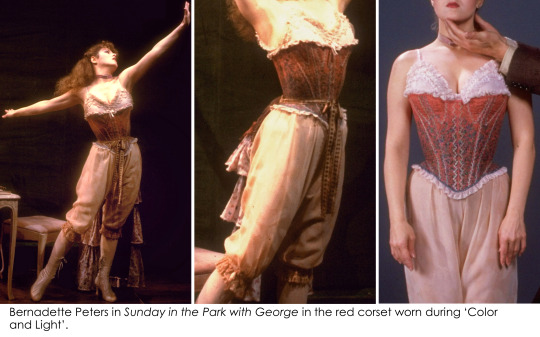
At first, I began to set out to address the contributions made to the show by designer Patricia Zipprodt in collaboration with Ann Hould-Ward. Quickly I fell into a (rather substantial) tangent rabbit hole – concerning over a century’s worth of interconnected designers who are responsible for hundreds of some of the most memorable Broadway shows between them.
It is impossible to look at the work of just one or two of these women without also discussing the others that came before them or were inspired by them.
Journey with me then if you will on this retrospective endeavour to explore the work and legacy that some of these designers have created, and some of the contexts in which they did so.
A set of podcasts featuring Ann Hould-Ward, including Behind the Curtain (Ep. 229) and Broadway Nation (Eps. 17 and 18), invaluably introduce some of the information discussed here and, most crucially, provide a first-hand, verbal link back to this history. The latter show sets out the case for a “succession of dynamic women that goes back to the earliest days of the Broadway musical and continues right up to today”, all of whom “were mentored by one or more of the great [designers] before them, [all] became Tony award-winning [stars] in their own right, and [all] have passed on the [craft] to the next generation.”
A chronological, linear descendancy links these designers across multiple centuries, starting in 1880 with Aline Bernstein, then moving to Irene Sharaff, then to Patricia Zipprodt, then to the present day with Ann Hould-Ward. Other designers branch from or interact with this linear chronology in different ways, such as Florence Klotz and Ann Roth – who, like Patricia Zipprodt, were also mentored by Aline Bernstein – or Theoni V. Aldredge, who stands apart from this connected tree, but whose career closely parallels the chronology of its central portion. There were, of course, many other designers and women also working within this era that provided even further momentous contributions to the world of costume design, but in this piece, the focus will remain primarily on these seven figures.

As the main creditor of the designs for Sunday in the Park with George, let’s start with Patricia (Pat) Zipprodt.
Born in 1925, Pat studied at the Fashion Institute of Technology (FIT) in New York after winning a scholarship there in 1951. Through teaching herself “all of costume history by studying materials at the New York Public Library”, she passed her entrance exam to the United Scenic Artists Union in 1954. This itself was a feat only possible through Aline Bernstein’s pioneering steps in demanding and starting female acceptance into this same union for the first time just under 30 years previously.
Pat made her individual costume design debut a year after assisting Irene Sharaff on Happy Hunting in 1956 – Ethel Merman’s last new Broadway credit. Of the more than 50 shows she subsequently designed, some of Pat’s most significant musicals include:
She Loves Me (1963)
Fiddler on the Roof (1964)
Cabaret (1966)
Zorba (1968)
1776 (1969)
Pippin (1972)
Mack & Mabel (1974)
Chicago (1975)
Alice in Wonderland (1983)
Sunday in the Park with George (1984)
Sweet Charity (1986)
Into the Woods (1987) - preliminary work
Other notable play credits included:
The Little Foxes (1967)
The Glass Menagerie (1983)
Cat on a Hot Tin Roof (1990)

Yes. One person designed all of those shows. Many of the most beloved pieces in modern musical theatre history. Somewhat baffling.
Her work notably earned her 11 Tony nominations, 3 wins, an induction into the Theatre Hall of Fame in 1992, and the Irene Sharaff award for lifetime achievement in costume design in 1997.
By 1983, Pat was one of the most well-respected designers of her era. When the offer for Sunday in the Park with George came in, she was less than enamoured by being confined to the ill-suited basements at Playwright’s Horizons all day, designing full costumes for a story not even yet in existence. From-the-ground-up workshops are common now, but at the time, Sunday was one of the first of its kind.
Rather than flatly declining, she asked Ann Hould-Ward, previously her assistant and intern who had now been designing for 2-3 years on her own, if she was interested in collaborating. She was. The two divided the designing between them, like Pat creating Bernadette’s opening pink and white dress, and Ann her final red and purple dress.

Which indeed leads to the question of the infamous creation worn in the opening number. No attemptedly comprehensive look at the costumes in Sunday would be complete without addressing it or its masterful mechanics.
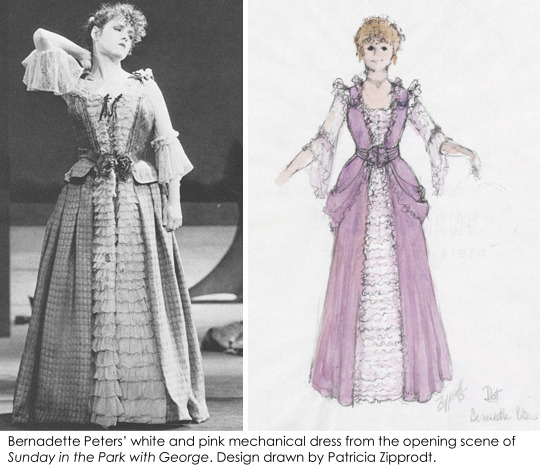
To enable Bernadette to spring miraculously and seemingly effortlessly from her outer confines, Ann and Pat enlisted the help of a man with a “Theatre Magics” company in Ohio. Dubbed ‘The Iron Dress’, the gasp-inducing motion required a wire frame embedded into the material, entities called ‘moonwalker legs and feet’, and two garage door openers coming up through the stage to lever the two halves apart. The mechanism – highly impressive in its periods of functionality – wasn’t without its flaws. Ann recalls “there were nights during previews where [Bernadette] couldn’t get out of the dress”. Or worse, a night where “the dress closed up completely. And it wouldn’t open up again!”. As Bernadette finished her number, there was nothing else within her power she could do, so she simply “grabbed it under her arm and carried it off stage.”
What visuals. Evidently, the course of costume design is not always plain sailing.
This sentiment is exhibited in the fact design work is a physical materialisation of other creators’ visions, thus foregrounding the tricky need for collaboration and compromise. This is at once a skill, very much part of the job description, and not always pleasant – in navigating any divides between one’s own ideas and those of other people.
Sunday in the Park with George was no exception in requiring such a moment of compromise and revision. With the show already on Broadway in previews, Stephen Sondheim decreed the little girl Louise’s dress “needs to be white” – not the “turquoisey blue” undertone Pat and Ann had already created it with. White, to better spotlight the painting’s centre.
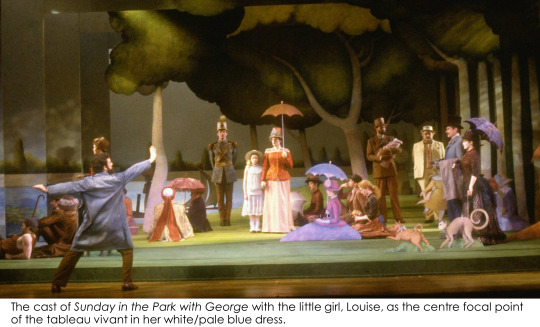
Requests for alterations are easier to comprehend when they are done with equanimity and have justification. Sondheim said he would pay for the new dress himself, and in Seurat’s original painting, the little girl is very brightly the focal centre point of the piece. On this occasion, all agreed that Sondheim was “absolutely right”. A new dress was made.
Other artistic differences aren’t always as amicable.
In Pat Zipprodt’s first show, Happy Hunting with Ethel Merman in 1956, some creatives and directors were getting in vociferous, progress-stopping arguments over a dress and a scene in which Ethel was to jump over a fence. Then magically, the dress went missing. Pat was working at the time as an assistant to the senior Irene Sharaff, and Pat herself was the one to find the dress the next morning. It was in the basement. Covered in black and wholly unwearable. Sharaff had spray painted the dress black in protest against the “bickering”. Indeed, Sharaff disappeared, not to be seen again until the show arrived on Broadway.
Those that worked with her soon found that Sharaff was one to be listened to and respected – as Hal Prince did during West Side Story. After the show opened in 1957, Hal replaced her 40 pairs of meticulously created and individually dyed, battered, and re-dyed jeans with off-the-rack copies. His reasoning was this: “How foolish to be wasting money when we can make a promotional arrangement with Levi Strauss to supply blue jeans free for program credit?” A year later, he looked at their show, and wondered “What’s happened?”
What had happened was that the production had lost its spark and noticeable portions of its beauty, vibrancy, and subtle individuality. Sharaff’s unique creations quickly returned, and Hal had learned his lesson. By the time Sharaff’s mentee, Pat, had “designed the most expensive rags for the company to wear” with this same idiosyncratic dyeing process for Fiddler on the Roof in 1964, Hal recognised the value of this particularity and the disproportionately large payoff even ostensibly simple garments can bring.
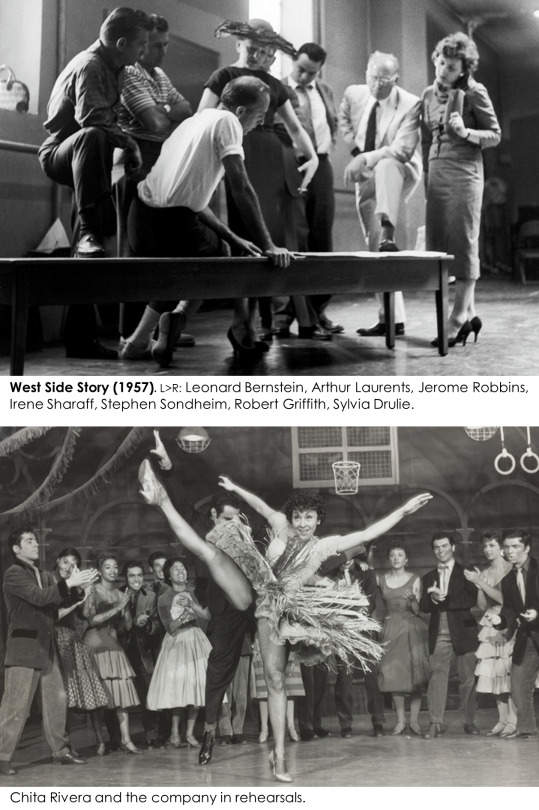
Irene Sharaff is remembered as one of the greatest designers ever. Born in 1910, she was mentored by Aline Bernstein, first assisting her on 1928’s original staging of Hedda Gabler.
Throughout her 56 year career, she designed more than 52 Broadway musicals. Some particularly memorable entities include:
The Boys from Syracuse (1938)
Lady in the Dark (1943)
Candide (1956)
Happy Hunting (1956)
Sweet Charity (1966)
The King and I (1951, 1956)
West Side Story (1957, 1961)
Funny Girl (1964, 1968)
For the last three productions, she would reprise her work on Broadway in the subsequent and indelibly enduring film adaptations of the same shows.
Her work in the theatre earned her 6 Tony nominations and 1 win, though her work in Hollywood was perhaps even more well rewarded – earning 5 Academy Awards from a total of 15 nominations.
Some of Sharaff’s additional film credits included:
Meet Me in St. Louis (1944)
Ziegfeld Follies (1946)
An American in Paris (1951)
Call Me Madam (1953)
A Star is Born (1954) – partial
Guys and Dolls (1955)
Cleopatra (1963)
Who’s Afraid of Virginia Woolf? (1966)
Hello Dolly! (1969)
Mommie Dearest (1981)
It’s a remarkable list. But it is too more than just a list.
Famously, Judy’s red scarlet ballgown in Meet Me in St. Louis was termed the “most sophisticated costume [she’d] yet worn on the screen.”
It has been written that Sharaff’s “last film was probably the only bad one on which she worked,” – the infamous pillar of camp culture, Mommie Dearest, in 1981 – “but its perpetrators knew that to recreate the Hollywood of Joan Crawford, it required an artist who understood the particular glamour of the Crawford era.” And at the time, there were very few – if any – who could fill that requirement better than Irene Sharaff.
The 1963 production of Cleopatra is perhaps an even more infamous endeavour. Notoriously fraught with problems, the film was at that point the most expensive ever made. It nearly bankrupted 20th Century Fox, in light of varying issues like long production delays, a revolving carousel of directors, the beginning of the infamous Burton/Taylor affair and resulting media storm, and bouts of Elizabeth’s ill-health that “nearly killed her”. In that turbulent environment, Sharaff is highlighted as one of the figures instrumental in the film’s eventual completion – “adjusting Elizabeth Taylor’s costumes when her weight fluctuated overnight” so the world finally received the visual spectacle they were all ardently anticipating.

But even beyond that, Sharaff’s work had impacts more significantly and extensively than the immediate products of the shows or films themselves. Within a few years of her “vibrant Thai silk costumes for ‘The King and I’ in 1951, …silk became Thailand’s best-known export.” Her designs changed the entire economic landscape of the country.
It’s little wonder that in that era, Sharaff was known as “one of the most sought-after and highest-paid people in her profession.” With discussions and favourable comparisions alongside none other than Old Hollywood’s most beloved designer, Edith Head, Irene deserves her place in history to be recognised as one of the foremost significant pillars of the design world.
In this respected position, Irene Sharaff was able to pass on her knowledge by mentoring others too as well as Patricia Zipprodt, like Ann Roth and Florence Klotz, who have in turn gone on to further have their own highly commendable successes in the industry.
Florence “Flossie” Klotz, born in 1920, is the only Broadway costume designer to have won six Tony awards. She did so, all of them for musicals, and all of them directed by Hal Prince, in a marker of their long and meaningful collaboration.
Indeed, Flossie’s life partner was Ruth Mitchell – Hal’s long-time assistant, and herself legendary stage manager, associate director and producer of over 43 shows. Together, Flossie and Ruth were dubbed a “power couple of Broadway”.
Flossie’s shows with Hal included:
Follies (1971)
A Little Night Music (1973)
Pacific Overtures (1976)
Grind (1985)
Kiss of the Spiderwoman (1993)
Show Boat (1995)
And additional shows amongst her credits extend to:
Side by Side by Sondheim (1977)
On the Twentieth Century (1978)
The Little Foxes (1981)
A Doll’s Life (1982)
Jerry’s Girls (1985)
Earlier in her career, she would first find her footing as an assistant designer on some of the Golden Age’s most pivotal shows like:
The King and I (1951)
Pal Joey (1952)
Silk Stockings (1955)
Carousel (1957)
The Sound of Music (1959)
The original production of Follies marked the first time Florence was seriously recognised for her work. Before this point, she was not yet anywhere close to being considered as having broken into the ranks of Broadway’s “reigning designers” of that era. Follies changed matters, providing both an indication of the talent of her work to come, and creating history in being commended for producing some of the “best costumes to be seen on Broadway” in recent memory – as Clive Barnes wrote in The New York Times. Fuller discussion is merited given that the costumes of Follies are always one of the show’s central points of debate and have been crucial to the reception of the original production as well as every single revival that has followed in the 50 years since.

In this instance, Ted Chapin would record from his book ‘Everything Was Possible: The Birth of the Musical ‘Follies’ how “the costumes were so opulent, they put the show over-budget.” Moreover, that “talking about the show years later, [Florence] said the costumes could not be made today. ‘Not only would they cost upwards of $2 million, but we used fabrics from England that aren’t even made anymore.’” Broadway then does indeed no longer look like Broadway now.
This “surreal tableau” Flossie created, including “three-foot-high ostrich feather headdresses, Marie Antoinette wigs adorned with musical instruments and birdcages, and gowns embellished with translucent butterfly wings”, remains arguably one of the most impressive and jaw-dropping spectacles to have ever graced a Broadway stage even to this day.
As for Ann Roth, born in 1931, she is still to this day making her own history – recently becoming the joint eldest nominee at 89 for an Oscar (her 5th), for her work on 2020′s Ma Rainey’s Black Bottom. Now as of April 26th, Ann has just made history even further by becoming the oldest woman to win a competitive Academy Award ever. She has an impressive array of Hollywood credits to her name in addition to a roster of Broadway design projects, which have earned her 12 Tony nominations.
Some of her work in the theatre includes:
The Women (1973)
The Best Little Whorehouse in Texas (1978)
They're Playing Our Song (1979)
Singin' in the Rain (1985)
Present Laughter (1996)
Hedda Gabler (2009)
A Raisin in the Sun (2014)
Shuffle Along (2016)
The Prom (2018)
Making her way over to Hollywood in the ‘70s, she has left an indelible and lasting visual impact on the arts through films like:
Klute (1971)
The Goodbye Girl (1977)
Hair (1979)
9 to 5 (1980)
Silkwood (1983)
Postcards from the Edge (1990)
The Birdcage (1996)
The Hours (2002)
Mamma Mia! (2008)
Ma Rainey’s Black Bottom (2020)

It’s clear from this branching 'tree' to see how far the impact of just one woman passing on her time and knowledge to others who are starting out can spread.
This art of acting as a conduit for valuable insights was something Irene Sharaff had learned from her own mentor and predecessor, Aline Bernstein. Aline was viewed as “the first woman in the [US] to gain prominence in the male-dominated field of set and costume design,” and was too a strong proponent of passing on the unique knowledge she had acquired as a pioneer and forerunner in the field.
Born in 1880, Bernstein is recognised as “one of the first theatrical designers in New York to make sets and costumes entirely from scratch and craft moving sets” while Broadway was still very much in its infancy of taking shape as the world we know today. This she did for more than one hundred shows over decades of her work in the theatre. These shows included the spectacular Grand Street Follies (1924-27), and original premier productions of plays like some of the following:
Ibsen’s Hedda Gabler (1928)
J.M Barrie’s Peter Pan (1928)
Grand Hotel (1930)
Phillip Barry’s Animal Kingdom (1932)
Chekov’s The Seagull (1937)
Both Lillian Hellman’s The Children’s Hour (1934) and The Little Foxes (1939)

Beyond direct design work, Bernstein founded what was to become the Neighbourhood Playhouse (the notable New York acting school) and was influential in the “Little Theatre movement that sprung up across America in 1910”. These were the “forerunners of the non-profit theatres we see today” and she continued to work in this realm even after moving into commercial theatre.
Bernstein also established the Museum of Costume Art, which later became the Costume Institute of the Met Museum of Art, where she served as president from 1944 to her death in 1955. This is what the Met Gala raises money for every year. So for long as you have the world’s biggest celebrities parading up and down red carpets in high fashion pieces, you have Aline Bernstein to remember – as none of that would be happening without her.
During the last fifteen years of her life, Bernstein taught and served as a consultant in theatre programs at academic institutions including Yale, Harvard, and Vassar – keen to connect the community and facilitate an exchange of wisdom and information to new descendants and the next generation.
Many designers came somewhere out of this linear descendancy. One notable exception, with no American mentor, was Theoni V. Aldredge. Born in 1922 and trained in Greece, Theoni emigrated to the US, met her husband, Tom Aldredge – himself of Into the Woods and theatre notoriety – and went on to design more than 100 Broadway shows. For her work, she earned 3 Tony wins from 11 nominations from projects such as:
Anyone Can Whistle (1964)
A Chorus Line (1975)
Annie (1977)
Barnum (1980)
42nd Street (1980)
Woman of the Year (1981)
Dreamgirls (1981)
La Cage aux Folles (1983)
The Rink (1984)
One of the main features that typify Theoni’s design style and could be attributed to a certain unique and distinctive “European flair” is her strong use of vibrant colour. This is a sentiment instantly apparent in looking longitudinally at some of her work.

In Ann Hould-Ward’s words, Theoni speaks to the “great generosity” of this profession. Theoni went out of her way to call Ann apropos of nothing early in the morning at some unknown hotel just after Ann won her first Tony for Beauty and the Beast in 1994, purring “Dahhling, I told you so!” These were women that had their disagreements, yes, but ultimately shared their knowledge and congratulated each other for their successes.
Similar anecdotal goodwill can be found in Pat Zipprodt’s call to Ann on the night of the 1987 Tony’s – where Ann was nominated for Into the Woods – with Pat singing “Have wonderful night! You’re not gonna win! …[laugh] but I love you anyway!”
This well-wishing phone call is all the more poignant considering Pat was originally involved with doing the costumes for Into the Woods, in reprise of their previous collaboration on Sunday in the Park with George.
If, for example, Theoni instinctively is remembered for bright colour, one of the features that Pat is first remembered for is her dedicated approach to research for her designs. Indeed, the New York Public Library archives document how the remaining physical evidence of this research she conducted is “particularly thorough” in the section on Into the Woods. Before the show finally hit Broadway in 1987 with Ann Hould-Ward’s designs, records show Pat had done extensive investigation herself into materials, ideas and prospective creations all through 1986.
Both Ann and Pat worked on the show out of town in try-outs at the Old Globe theatre in San Diego. But when it came to negotiating Broadway contracts, the situation became “tricky” and later “untenable” with Pat and the producers. Ann was “allowed to step in and design” the show alone instead.
The lack of harboured resentment on Patricia’s behalf speaks to her character and the pair’s relationship, such that Ann still considered her “my dear and beloved friend” for over 25 years, and was “at [Pat’s] bed when she died”.
Though they parted ways ultimately for Into the Woods, you can very much feel a continuation between their work on Sunday in the Park with George a few years previously, especially considering how tactile the designs appear in both shows. This tactility is something the shows’ book writer and director, James Lapine, was specific about. Lapine would remark in his initial ideas and inspirations that he wanted a graphic quality to the costumes on this occasion, like “so many sketches of the fairy-tales do”.
Ann fed that sentiment through her final creations, with a wide variety of materials and textures being used across the whole show – like “ribbons with ribbons seamed through them”, “all sorts of applique”, “frothy organzas and rembriodered organzas”. A specific example documents how Joanna Gleason’s shawl as the Baker’s Wife was pieced together, cut apart, and put back together again before resembling its final form.
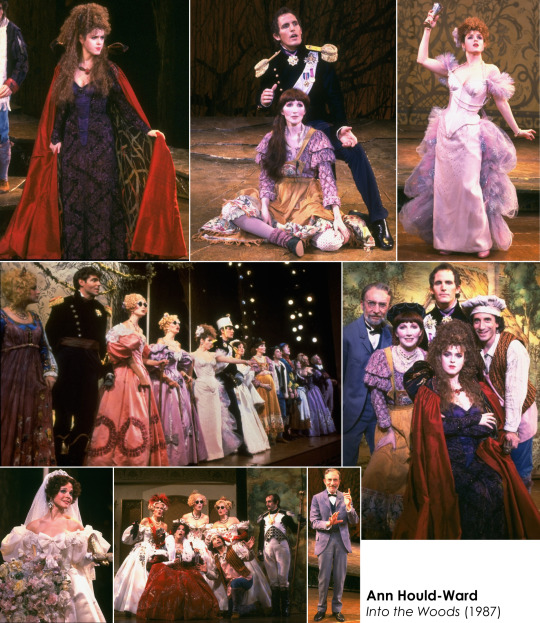
This highly involved principle demonstrates another manner of inventive design that uses a different method but maintains the aim of particularity as discussed previously with Patricia and Irene’s complex dyeing and re-dyeing process. Pushing the confines of what is possible with the materials at hand to create a variety of colours, shades, and textures ultimately produces visual entities that are complex to look at. Confusing the eye like this “holds attention longer”, Ann maintains, which makes viewers look more intricately at individual segments of the production, and enables the costume design to guide specific focus by not immediately ceding attention elsewhere.
Understanding the methods behind the resultant impacts of a show can be as, if not more, important and interesting than the final product of the show itself sometimes. A phone call Ann had last August with James Lapine reminds us this is a notion we may be treated more to in the imminent future, when he called to enquire as to the location of some design sketches for the book he is working on (Putting It Together: How Stephen Sondheim and I Created 'Sunday in the Park with George') to document more thoroughly the genesis of the pair’s landmark and beloved musical.
In continuation of the notion that origin stories contain their own intrinsic value beyond any final product, Ann first became Pat’s intern through a heart-warming and tenacious tale. Ann sent letters to three notable designers when finishing graduate school. Only Patricia Zipprodt replied, with a message to say she “didn’t have anything now but let me think about it and maybe in the future.” It got to the future, and Ann took the encouragement of her previous response to try and contact Pat again. Upon being told she was out of town with a show, Ann proceeded to chase Pat through various phone books and telephone wires across different states and theatres until she finally found her. She was bolstered by the specifics of their call and ran off the phone to write an imploring note – hinging on the premise of a shared connection to Montana. She took an arrow, stabbed it through a cowboy hat, put it in a box with the note that was written on raw hide, and mailed it to New York with bated breath and all of her hopes and wishes.
Pat was knife-edgingly close to missing the box, through a matter of circumstance and timing. Importantly, she didn’t. Ann got a response, and it boded well: “Alright alright alright! You can come to New York!”
Subsequently, Ann’s long career in the design world of the theatre has included notable credits such as:
Sunday in the Park with George (1984)
Into the Woods (1987, 1997)
Falsettos (1992)
Beauty and the Beast (1994, 1997)
Little Me (1998)
Company (2006)
Road Show (2008)
The People in the Picture (2011)
Merrily We Roll Along (1985, 1990, 2012, segment in Six by Sondheim 2013)
Passion (2013)
The Visit (2015)
The Color Purple (2015)
The Prince of Egypt (2021)
From early days in the city sleeping on a piece of foam on a friend’s floor, to working collaboratively alongside Pat, to using what she’d learnt from her mentor in designing whole shows herself, and going on to win prestigious awards for her work – the cycle of the theatre and the importance of handing down wisdom from those who possess it is never more evident.
As Ann summarises it meaningfully, “the theatre is a continuing, changing, evolving, emotional ball”. It’s raw, it’s alive, it needs people, it needs stories, it needs documentation of history to remember all that came before.
In periods where there can physically be no new theatre, it’s made ever the more clear for the need not to forget what value there is in the tales to be told from the past.
Through this retrospective, we’ve seen the tour de force influence of a relatively small handful of women shaping a relatively large portion of the visual scape of some of Broadway’s brightest moments.
But it’s significant to consider how disproportionate this female impact was, in contrast with how massively male dominated the rest of the creative theatre industry has been across the last century.
Assessing variations in attitudes and approaches to relationships and families in these women in the context of their professional careers over this time period presents interesting observations. And indeed, manners in which things have changed over the past hundred years.
As Ann Hould-Ward speaks of her experiences, one of her reflections is how much this was a “very male dominated world”. And one that didn’t accommodate for women with families who also wanted careers. As an intern, she didn’t even feel she could tell Patricia Zipprodt about the existence of her own young child until after 6 months of working with her. With all of these male figures around them, it would be often questioned “How are you going to do the work? How are you going to manage [with a family]?”, and that it was “harder to convince people that you were going to be able to do out-of-towns, to be able to go places.” Simply put, the industry “didn't have many designers who were married with children.”
Patricia herself in the previous generation demonstrates this restricting ethos. “In 1993, Zipprodt married a man whose proposal she had refused some 43 years earlier.” She had just newly graduated college and “she declined [his proposal] and instead moved to New York.” Faced with the family or career conundrum, she chose the latter. By the 1950s, it then wasn’t seen as uncommon to have both, it was seen as impossible.
Her husband died just five years after the pair were married in 1998, as did Patricia herself the following year. One has to wonder if alternative decisions would’ve been made and lives lived differently if she’d experienced a different context for working women in her younger life.
But occupying any space in the theatre at all was only possible because of the efforts of and strides made by women in previous generations.
When Aline Bernstein first started designing for Broadway theatre in 1916, women couldn’t even vote. She became the first female member of the United Scenic Artists of America union in 1926, but only because she was sworn in under the false and male moniker of brother Bernstein. In fact, biographies often centralise on her involvement in a “passionate” extramarital love affair with novelist Thomas Wolfe – disproportionately so for all of her remarkable contributions to the theatrical, charitable and academic worlds, and instead having her life defined through her interactions with men.
As such, it is apparent how any significant interactions with men often had direct implications over a woman’s career, especially in this earlier half of the century. Only in their absence was there comparative capacity to flourish professionally.
Irene Sharaff had no notable relationships with men. She did however have a significant partnership with Chinese-American painter and writer Mai-mai Sze from “the mid-1930s until her death”. Though this was not (nor could not be) publicly recognised or documented at the time, later by close acquaintances the pair would be described as a “devoted couple”, “inseparable”, and as holding “love and admiration for one another [that] was apparent to everyone who knew them.” This manner of relationship for Irene in the context of her career can be theorised as having allowed her the capacity to “reach a level of professional success that would have been unthinkable for most straight women of [her] generation”.
Moving forwards in time, Irene and Mai-mai presently rest where their ashes are buried under “two halves of the same rock” at the entrance to the Music and Meditation Pavilion at Lucy Cavendish College in Cambridge, which was “built following a donation by Sharaff and Sze”. I postulate that this site would make for an interesting slice of history and a perhaps more thought-provoking deviation for tourists away from being shepherded up and down past King’s College on King’s Parade as more usually upon a visit to Cambridge.
In this more modern society at the other end of this linear tree of remarkable designers, options for women to be more open and in control of their personal and professional lives have increased somewhat.
Ann Hould-Ward later in her career would no longer “hide that [she] was a mother”, in fear of not being taken seriously. Rather, she “made a concerted effort to talk about [her] child”, saying “because at that point I had a modicum of success. And I thought it was supportive for other women that I could do this.”
If one aspect passed down between these women in history are details of the craft and knowledge accrued along the way, this statement by Ann represents an alternative facet and direction that teaching of the future can take. Namely, that by showing through example, newer generations will be able to comprehend the feasibility of occupying different options and spaces as professional women. Existing not just as designers, or wives, or mothers, or all, or one – but as people, who possess an immense talent and skill. And that it is now not just possible, but common, to be multifaceted and live the way you want to live while working.
This is not to say all of the restrictions and barriers faced by women in previous generations have been removed, but rather that as we build a larger wealth of history of women acting with autonomy and control to refer back to, things can only get easier to build upon for the future.
Who knows what Broadway and theatre in general will look like when it returns – both on the surface with respect to this facet of costume design, and also more deeply as to the inner machinations of how shows are put together and presented. The largely male environment and the need to tick corporate and commercial boxes will not have vanished. One can only hope that this long period of stasis will have foregrounded the need and, most importantly, provided the time to revaluate the ethos in which shows are often staged, and the ways in which minority groups – like women – are able to work and be successful within the theatre in all of the many shows to come.
Notable sources:
Photographs – predominantly from the New York Public Library digital archives.
IBDB – the Internet Broadway Database.
Broadway Nation Podcast (Eps. #17 and #18), David Armstrong, featuring Ann Hould-Ward, 2020.
Behind the Curtain: Broadway’s Living Legends Podcast (Ep. #229), Robert W Schneider and Kevin David Thomas, featuring Ann Hould-Ward, 2020.
Sense of Occasion, Harold Prince, 2017.
Everything Was Possible: The Birth of the Musical ‘Follies’, Ted Chapin, 2003.
Finishing the Hat: Collected Lyrics (1954–1981) with Attendant Comments, Principles, Heresies, Grudges, Whines and Anecdotes, Stephen Sondheim, 2010.
The Complete Book of 1970s Broadway Musicals, Dan Deitz, 2015.
The Complete Book of 1980s Broadway Musicals, Dan Dietz, 2016.
Inventory of the Patricia Zipprodt Papers and Designs at the New York Public Library, 2004 – https://www.nypl.org/sites/default/files/archivalcollections/pdf/thezippr.pdf
Extravagant Crowd’s Carl Van Vecten’s Portraits of Women, Aline Bernstein – http://brbl-archive.library.yale.edu/exhibitions/cvvpw/gallery/bernstein.html
Jewish Heroes & Heroines of America: 150 True Stories of American Jewish Heroism – Aline Bernstein, Seymour Brody, 1996 – https://www.jewishvirtuallibrary.org/aline-bernstein
Ann Hould-Ward Talks Original “Into the Woods” Costume Designs, 2016 – https://www.youtube.com/watch?v=4EPe77c6xzo&ab_channel=Playbill
American Theatre Wing’s Working in the Theatre series, The Design Panel, 1993 – https://www.youtube.com/watch?v=9sp-aMQHf-U&t=2167s&ab_channel=AmericanTheatreWing
Journal of the History of Ideas Blog, Mai-mai Sze and Irene Sharaff in Public and in Private, Erin McGuirl, 2016 – https://jhiblog.org/2016/05/16/mai-mai-sze-and-irene-sharaff-in-public-and-in-private/
Irene Sharaff’s obituary, The New York Times, Marvine Howe, 1993 – https://www.nytimes.com/1993/08/17/obituaries/irene-sharaff-designer-83-dies-costumes-won-tony-and-oscars.html
Obituary: Irene Sharaff, The Independent, David Shipman, 2011 – https://www.independent.co.uk/news/people/obituary-irene-sharaff-1463219.html
Broadway Design Exchange – Florence Klotz – https://www.broadwaydesignexchange.com/collections/florence-klotz
Obituary: Florence Klotz, The New York Times, 2006 – https://www.nytimes.com/2006/11/03/obituaries/03klotz.html
#bernadette peters#sunday in the park with george#costume design#costume designers#stephen sondheim#sondheim#broadway#theatre#tony awards#oscars#academy award nominations#ethel merman#judy garland#into the woods#theater#musical theater#fashion#dresses#meryl streep#elizabeth taylor#old hollywood#film#costumes#movies#musicals#writing#long reads#hollywood#actresses
162 notes
·
View notes
Note
W
Despite the numbering this likely won't be any true particular order:
Willkommen from Cabaret
Specifically the version sung by Alan Cumming cause it's the best and also I've only managed to watch the 1997 recording on YouTube. It's fucking great though, and very fun to sing along (especially if you try to emulate the accent)
2. We Both Reach For The Gun from Chicago (2003)
Either that or 'When You're Good To Mama'. Not a single song on that soundtrack is a flop and that's impressive. Just a really good song, very fast paced and satisfying to hear and sing
3. White Rabbit by Egypt Central
One time I posted the lyrics on my Snapchat when I was going through it in hopes someone would ask if I was okay azwxestrdcytfvgbhnjm. Despite that Mixed Association, just a good bit of angst, and I like me an Alice in Wonderland theme
4. Waidmanns Heil by Rammstein
This track FUCKS okay like goddamn this sounds great, a good heavy riff and bass or whatever the musical term is, just really good to stamp your foot to with a good chorus yell, fuckin love it
5. Would You Kindly by JTMusic
A song for one of my favourite villains from my favourite video game? Of course I love this. Another really good one to sing, very satisfying to memorize
5 notes
·
View notes
Note
So I was reading about the first Oscars ceremony, and it had a division between Outstanding Picture and Best Unique & Artistic Film, where Unique & Artistic was apparently meant to be an equal to Outstanding Picture but dedicated more for prestige artistic works. The next year, the two categories became one from then on, and Outstanding Picture was the only top prize. (If any of that is wrong, blame wikipedia.)
If the split had remained, and there was a more commercial-y movie top prize and a prestige art top prize, what are some notable movies that suddenly pick up wins?
okay wait........ this is a brilliant question and i am ashamed to say i’ve never really given it much thought until now.
idk if you’ve seen wings and sunrise but they’re both pretty great and they do represent wildly different kinds of filmmaking. while it’s safe to say Wings is the more commercial film, it has great craftsmanship behind it and it very clearly created the template for accessible, capital-i Important, and well-made best picture winners to come.
and, full transparency, sunrise is one of my, like, top 15 favorite movies, so i’m hella biased, but that movie is a gorgeous and strange and thrilling piece of work. the title “unique and artistic film” is impossibly vague, but watching sunrise makes it very, very clear that it fits that bill for that category. and while we’ll, of course, never know what might have happened if that category had continued, it’s tempting to think that all the winners in unique and artistic film would be of sunrise’s calibre, but knowing the oscars... that’s clearly a fantasy, lol. while sunrise is a wildly inventive and artistic film, it’s important to remember that it was fully on the academy’s radar -- janet gaynor won best actress in part for her performance in the film, and it also won best cinematography. so while it’s tempting to think the academy would always recognize a truly unique and artistic achievement every year, in all likelihood, they probably wouldn’t stray too far from the movies that were already on their radar.
so for this thought experiment!!
it’s probably safe to assume every best picture winner has to go in one of the two categories. there are only a handful of winners that stick out as maybe missing out on the big win in this new system, but only a handful.
so uh. this is way more than you asked but i got hooked. here’s what i think might have happened if the two best picture categories had stuck around. as i was working through the years, it became clear to me that, unfortunately, in a lot of years, the unique and artistic film would likely end up going to the more overtly “prestigious” films, such as the song of bernadette or the life of emile zola, while their far better and more commercially viable rivals (casablanca for bernadette, the awful truth for zola) would win outstanding picture. the actual best picture winners have an asterisk next to them. what’s also interesting to consider is the importance of the best director category: most of the time, a split in picture and director will tell you what’s clearly the runner-up. those years, usually, give you a good sense of how the two awards would shake out.
Outstanding Picture / Unique and Artistic Film
1929: The Broadway Melody*; The Divine Lady
1930: The Big House; All Quiet on the Western Front*
1931: Cimarron*; Morocco
1932: Grand Hotel*; Bad Girl
1933: Little Women; Cavalcade*
1934: It Happened One Night*; One Night of Love
1935: The Informer; A Midsummer Night’s Dream (** this is one of the few years i think the actual BP winner, Mutiny on the Bounty, would miss out; The Informer was clearly the runner-up for BP with wins in director, actor, and screenplay, while Midsummer was seen as THE artistic triumph of the year, and with its historic write-in cinematography win, there was clearly a lot of passion for it)
1936: Mr. Deeds Goes to Town; The Great Ziegfeld*
1937: The Awful Truth; The Life of Emile Zola*
1938: You Can’t Take It With You*; Snow White and the Seven Dwarfs or Grand Illusion (** this one’s tough... Grand Illusion made history as the first non-english movie nominated for BP, and it clearly had a lot of support, but Snow White was such a monumental moment in Hollywood, and the academy clearly acknowledged that with its honorary award)
1939: Gone with the Wind*; The Wizard of Oz (** this is one of the first years with a clear runaway favorite for best picture, which makes guessing the way the other award would go very difficult! i’m leaning towards Oz purely because of its technical achievements, but i’m not confident about that choice at all.)
1940: Rebecca*; The Grapes of Wrath
1941: How Green Was My Valley*; Citizen Kane
1942: Yankee Doodle Dandy; Mrs. Miniver*
1943: Casablanca*; The Song of Bernadette
1944: Going My Way*; Wilson
1945: The Bells of St. Mary’s; The Lost Weekend*
1946: The Best Years of Our Lives*; Henry V
1947: Gentleman’s Agreement*; A Double Life
1948: The Treasure of the Sierra Madre; Hamlet*
1949: All the King’s Men*; The Heiress
1950: All About Eve*; Sunset Boulevard
1951: A Place in the Sun; An American in Paris*
1952: The Greatest Show on Earth*; The Quiet Man
1953: Roman Holiday; From Here to Eternity*
1954: The Country Girl; On the Waterfront*
1955: Marty*; Picnic
1956: Around the World in 80 Days*; Giant
1957: Peyton Place; The Bridge on the River Kwai
1958: The Defiant Ones; Gigi*
1959: The Diary of Anne Frank; Ben-Hur*
1960: Elmer Gantry; The Apartment*
1961: West Side Story*; Judgment at Nuremberg
1962: To Kill a Mockingbird; Lawrence of Arabia*
1963: Tom Jones*; 8½
1964: Mary Poppins; My Fair Lady*
1965: The Sound of Music*; Doctor Zhivago
1966: A Man for All Seasons*; Who’s Afraid of Virginia Woolf?
1967: In the Heat of the Night*; The Graduate
1968: Oliver!*; 2001: A Space Odyssey
1969: Midnight Cowboy; Z
1970: Airport; Patton*
1971: The French Connection*; The Last Picture Show
1972: The Godfather; Cabaret
1973: The Sting*; The Exorcist
1974: Chinatown; The Godfather, Part II
1975: Jaws; One Flew Over the Cuckoo’s Nest*
1976: Rocky*; Network
1977: Star Wars; Annie Hall*
1978: Coming Home; The Deer Hunter*
1979: Kramer vs. Kramer*; All That Jazz
1980: Ordinary People*; Raging Bull
1981: Chariots of Fire*; Reds
1982: E.T. the Extra-Terrestrial; Gandhi*
1983: Terms of Endearment*; Fanny and Alexander
1984: Amadeus*; The Killing Fields
1985: Out of Africa*; Ran
1986: Platoon*; Blue Velvet
1987: Moonstruck; The Last Emperor*
1988: Rain Man*; Who Framed Roger Rabbit
1989: Driving Miss Daisy*; Born on the Fourth of July
1990: Ghost; Dances with Wolves*
1991: The Silence of the Lambs*; JFK
1992: Unforgiven*; Howards End
1993: Schindler’s List*; The Piano
1994: Forrest Gump*; Three Colors: Red
1995: Braveheart*; Toy Story
1996: Jerry Maguire; The English Patient*
1997: Titanic*; L.A. Confidential
1998: Shakespeare in Love*; Saving Private Ryan
1999: The Cider House Rules; American Beauty*
2000: Traffic; Crouching Tiger, Hidden Dragon (** this is another year where i think the actual BP winner, Gladiator, might have missed out. it was a tight three-way race going into oscar night, and if there were two BP awards, i think this consensus might have settled, leaving Gladiator to go home with just actor and some tech awards.)
2001: A Beautiful Mind*; Mulholland Drive
2002: Chicago*; The Pianist
2003: Mystic River; The Lord of the Rings: The Return of the King*
2004: Million Dollar Baby*; The Aviator
2005: Crash*; Brokeback Mountain
2006: The Departed*; Babel
2007: No Country for Old Men*; The Diving Bell and the Butterfly
2008: The Dark Knight; Slumdog Millionaire*
2009: The Hurt Locker*; Avatar
2010: The King’s Speech*; The Social Network
2011: The Artist*; The Tree of Life
2012: Argo*; Life of Pi
2013: 12 Years a Slave*; Gravity
2014: Birdman*; Boyhood
2015: Spotlight*; The Revenant
2016: La La Land; Moonlight*
2017: Three Billboards Outside Ebbing, Missouri; The Shape of Water*
2018: Black Panther; Roma (** again, i think Green Book gets bumped out in this scenario, i think Black Panther is precisely the kind of movie that benefits from an award that’s seemingly more ~populist~ while Roma easily snags the unique & artistic prize)
2019: 1917; Parasite*
2020: The Father; Nomadland*
but of course i have no idea at all, and most of these are just my gut reactions lol. what a fun question!
22 notes
·
View notes
Note
I've watch Frasier and Bob's Burger. I love it. You have such a good taste sweetheart.
As you can see i like your taste in series soo can you give a list of your series and films recommendation?
Ah! I'm so glad you enjoy them!
This is so sweet especially because I lowkey think I have absolutely horrendous (and/or just bizarre) taste, so I'm thrilled to hear that you like them, too!
In terms of other series I enjoy: I do not watch a lot of television, but I'm a big fan of Murder, She Wrote, Poirot, and Miss Marple (these are technically ITV series, but they're straight up like mini-movies). I really liked Downton Abbey until, like, season 4 or so. I watch Big Mouth a little, Brooklyn 99 (I have to be in a very specific mood to sit down and watch TV, so it really just depends on that). I grew up watching a lot of British television like The Vicar of Dibley and Are You Being Served?, which I like a lot as well. I grew up watching Friends and I like it as a comfort thing, but I barely 'watch' it, if that makes any sense. I will also...ever so occasionally watch documentaries about ghosts (I don't like ghost hunter things because I believe in ghosts and that feels...rude to the ghosts?) and Old Hollywood.
In terms of film, I'm all over the place. I like slightly creepy stuff and old stuff. My favorite film of all time is The Philadelphia Story, which is a classic farce based on a play and it stars Katharine Hepburn, Jimmy Stewart (who I adore), and Cary Grant. I'm a big fan of Bringing Up Baby (which also stars Katharine Hepburn), Mr. Smith Goes to Washington (another Jimmy Stewart film). I love Alfred Hitchcock movies and my favorite is probably Rear Window. While it isn't a Hitchcock film, I love Charade, Wait Until Dark, and How to Steal a Million (all of which star Audrey Hepburn). I studied theatre and the best movie musicals I've ever seen are Cabaret, The Sound of Music, Meet Me in St. Louis, and Funny Face. I love period romance films, too, like Emma (2020), Sense and Sensibility (the one directed by Ang Lee and written by Emma Thompson because oh my GOD), and the 2005 Pride and Prejudice adaptation. Oh, and An Education.
I'm trying desperately to become like...a film buff? If I had my time again, I'd minor in film studies because I'm a huge fan of it...but I'm not smart enough to, like, talk about it? So, I'll occasionally try and watch, like, a 'smart' movie? In this category of films, there are more critically acclaimed things like When Harry Met Sally or Network or Misery or In the Mood for Love. From this year's Oscar nominees, I loved Nomadland and Promising Young Woman a whole bunch.
However, I also just like what I like and I'm fortunate enough to be getting to an age where I really just watch what I want to watch and don't watch what I don't want to. I'm really easy to please, which is helpful. Growing up, my favorite films were things like Return to Oz, The Cheap Detective, Clue, A League of Their Own, Hocus Pocus, The Addams Family, Who Framed Roger Rabbit?, Corpse Bride (which I still list in my top 5 films of all time), The Secret Garden (1993 one, I think), Little Women, Bedknobs and Broomsticks, and Practical Magic (comfort tip: if you're having a bad day, cut yourself a slice of banana or pumpkin bread, pour a coffee or tea to have with it and watch Practical Magic; it cures the soul).
When I was young, I also listened to director commentaries on movies all the time, still do, sometimes, so I always recommend doing that because it's super fun and interesting. I, like, love knowing why a director wanted a certain actor to stand where they're standing or, like, the symbolism behind a shot. I did this all the time for my favorite Disney films. My favorites are any of them where the art is slightly different or more interesting, so I really love Snow White (frankly, a miracle that film got made), Sleeping Beauty (there was a different animation director than the other original few films and you can really tell), and 101 Dalmatians.
To sum up, I'm a long-winded gal who enjoys old comedies, laughing, slightly spooky things, old-fashioned things and listening to slightly nerdy commentaries. Hope this was...informative? Slightly helpful? Fun?
Love you xx
2 notes
·
View notes
Text
“Hello hello all you lovely people! Did you all enjoy Ciar’s little event? We know we sure did..not. What kind of a party was THAT? There was no tea, how can you have a party with no tea? It’s just not done! Well lucky for you, the fun is just getting started!”
“Wonderland is ready and open for business! The hottest club on Dream Street, right here in the Diamond District! Step on in and relax! We’ve got food, drinks, lovely servers, and we know you just love bunnies right? Who doesn’t! You can even take in a show! We’re a cabaret you’d have to be mad to miss!”
“While you’re here make sure you stop in to our friendly neighbors, the Lightning Strikes Twice casino! Best of all, we’re hiring! So strap on those bunny ears and drop off an application!”
“Remember, tell them the Red Queen sent you and you’ll get a wonderful discount!”
“Just follow the white rabbit straight to your table or booth!”

2 notes
·
View notes